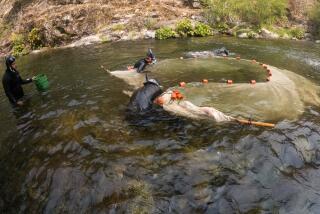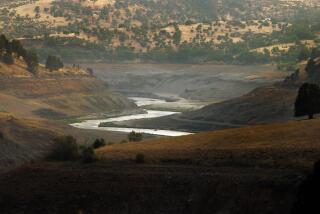Maine River Thrives After Dam Removed
- Share via
AUGUSTA, Maine — A year after giant backhoes tore down a dam that had blocked the Kennebec River for 162 years, sea-run fish are swimming upstream in stunning numbers and the water is more full of life than it has been in generations.
Conservationists say something else has been accomplished since the Edwards Dam became the first ordered removed by the federal government to protect the environment.
“It has made people realize that dam removal isn’t a crazy idea,” said Margaret Bowman of American Rivers, which also is targeting other dams across the country. “The debate has shifted from ‘Should any dam be removed?’ to ‘Does this dam make sense?’ ”
Since the removal of the Edwards Dam last year, two dozen others from Idaho to North Carolina have come down, and at least 18 others are scheduled to be removed this year, according to the environmental group.
The dams create power, protect towns from floods, improve navigation and provide irrigation, but environmentalists say hundreds of them across the country have outlived their usefulness and are causing environmental damage.
In Maine, removing Edwards Dam opened up an upstream stretch of the Kennebec River to Atlantic salmon, striped bass, endangered short-nosed sturgeon and other fish for the first time since the 1830s. Water quality has improved enough to support a healthy river ecosystem, say state environmental officials, who see more creatures and a wider range of life in the river.
Alewives migrated back from the ocean in such numbers this spring that people scooped them up by the bucketful 20 miles upstream from where the dam once sat. Atlantic salmon had found their way to their native waters just weeks after the demolition.
Recently, sturgeon have been seen leaping from waters where they had been absent since the days of Henry David Thoreau. Plus, it has opened up new recreational opportunities such as boating and fishing.
Environmentalists call the Kennebec’s revival a success. “Hopefully, what it will do is help other people’s attitudes as they look at other dams” that may be ripe for removal, said Andy Goode of the American Salmon Federation.
Edwards Dam was built in 1837 to provide power to riverside factories in Augusta. On July 1, 1999, Interior Secretary Bruce Babbitt watched along with hundreds of others as machines gouged an opening that let water flow through the 917-foot-wide dam that had spanned the Kennebec.
With its relatively low power output and advanced age, Edwards had long been targeted by conservationists nationally as a prime candidate for removal.
When its owners sought relicensing in 1997, the Federal Energy Regulatory Commission denied the application, ruling more benefit would be gained by opening the river to several species of sea-run fish than by keeping Edwards’ power generators humming.
Opponents argued the dam generated only one-tenth of 1% of the state’s power.
The Pros and Cons of Removing Dams
Edison Electric Institute, which represents shareholder-owned utilities that produce 75% of the nation’s electricity, believes the commission overstepped its authority when it ordered Edwards removed.
The association is concerned about the effect the dam’s removal could have on the country’s overall energy supply, spokesman Dan Riedinger said.
“We don’t want to see anything erode our ability to have a variety of sources of electricity available to us,” Riedinger said.
Unswayed by such arguments, environmentalists want to see four dams on the lower Snake River in Washington breached in order to protect wild salmon runs. Sen. Slade Gorton, R-Wash., has pledged to prevent their removal, which he said could cost the government $1 billion.
“Removal of Edwards doesn’t prove the Snake River dams should be removed,” said Bowman of American Rivers, which is a leader of the Washington effort. “But it shows that rivers can restore themselves when given the chance to do so.”
More to Read
Sign up for Essential California
The most important California stories and recommendations in your inbox every morning.
You may occasionally receive promotional content from the Los Angeles Times.













